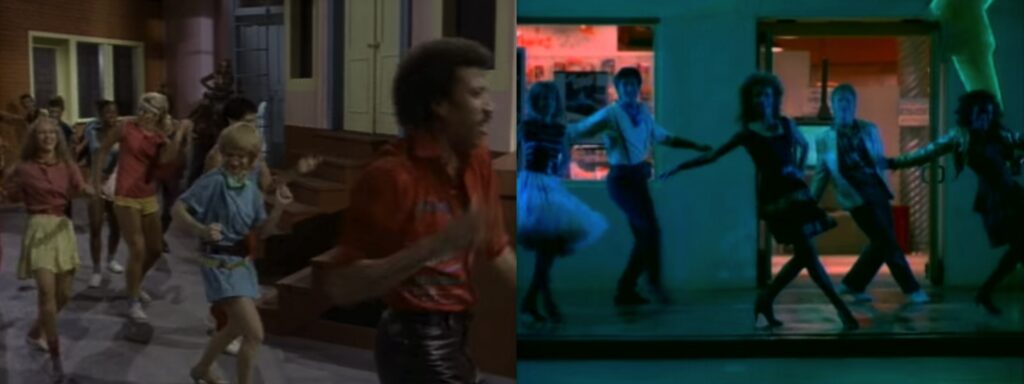By Paulo Camacho

A visual representation of rhythm — it’s part of the lifeblood of music; so much so, that songs are made about it.
It doesn’t take a rocket scientist to know that rhythm plays an indispensable role in the existence of music. After all, rhythm is basically defined as “the arrangement of sounds as they move through time.” It’s one of those concepts that is so easily taken for granted — while it is ever-present, in the form of both the music we listen to and the innocuous sounds of our everyday lives, one would be hard-pressed to describe rhythm, nor its importance to the natural world.
Leave it, then, to the music, itself, to simultaneously define and demonstrate this overlooked significance. We often see this representation in popular music — we are “Chained To The Rhythm”; we are enamored by the “Rhythm of Love”; we even believe, to a certain extent, that “Rhythm is a Dancer”. With that in mind, let’s take a look at three well-known (albeit old-school) songs that attempt to represent rhythm in its music:
Gloria Estefan — Rhythm is Gonna Get You
The 1987 dance-pop hit by Gloria Estefan and the Miami Sound Machine was the lead single for their album, Let It Loose. Written by Estefan and Enrique “Kiki” Garcia, the song reached No. 5 on the U.S. Billboard Hot 100, and was Estefan’s second Top-5 single. It was even featured in the 1987 Crime Comedy Stakeout. Much like Hall & Oates’ “Maneater” and its relation to New York City in the 1980s, Estefan personifies “the Rhythm” as an unyielding force that will hunt down and “get” the listener, no matter how much said listener tries to resist.
It’s sort of a meta-reference to the song, itself. To wit, the personification of “the rhythm” is essentially the Synth-Conga feel to the song, with its undeniable driving percussion — one that almost forces the listener to move to said rhythm. This siren call of the rhythm is apparent almost immediately, with the call-and-response chants to start the track, then reinforced by the percussion to establish its almost-hypnotic feel. In this sense, the rhythm truly is going to get the listener — between its driving percussion, the quick-tempoed bassline, and melodic voice of Gloria Estefan, the rhythm is almost irresistible.
DeBarge — Rhythm of the Night
This 1985 dance single from American recording group DeBarge was a departure of sorts, from the hit R&B ballads that they had built their name on in the early 1980s. While they were known to have pop dance songs in their repertoire, it wasn’t until “Rhythm of the Night” that their crossover appeal reached a crescendo. Considered one of the pop/R&B tracks that jump-started songwriter Diane Warren’s storied career, the idea behind the song was to take advantage of singer El DeBarge’s deep tenor voice, while also incorporating his trademark falsetto. The song also capitalized on the success of fellow Motown Records artist Lionel Richie, who was known for ballads until his own breakout crossover hit, “All Night Long.”
The parallels between Richie’s “All Night Long” and DeBarge’s “Rhythm of the Night” are evident — from the Caribbean influences of Calypso peppering both tracks, to the softened tenor voices juxtaposed against the energetic party-themed music, even to the themes of both artists’ music videos for their respective singles.

Two Peas in a ridiculously 80s Pod.
Considering the themes of both songs, the Calypso influences, combined with the lyrics, give the rhythmic representation of a distressed, anxiety-ridden population getting the much-needed outlet to unwind, relax and celebrate. The lively rhythms used, especially in DeBarge’s track, reflect this celebratory, de-stressing theme. And, much like the Estefan example from earlier, the song’s rhythm, much like the song suggests, gives off an infectious need to dance and celebrate.
Janet Jackson — Rhythm Nation
As the seminal track to Janet Jackson’s fourth album in 1989, entitled “Janet Jackson’s Rhythm Nation 1814,” “Rhythm Nation” served as a socially-conscious political response to various tragedies being reported in the media. Particularly, the spark for “Rhythm Nation” and a number of other tracks came from a news report on the infamous 1989 Stockton Playground Murders: a disgruntled drifter named Patrick Purdy, resentful of Cambodian immigrants for taking jobs he felt he deserved, shot up a playground at Cleveland Elementary in Stockton, California, killing 5 and injuring another 30. Jackson and co-producer Jimmy Jam Harris III wanted to make a song that represented racial unity and a utopian, colorblind world united by music and dance.
In order to represent these ideals in her music for “Rhythm Nation,” Jackson incorporated a number of stylized components. After all, the formulation of the song began with the idea that Jackson’s life centered around rhythm and beat. This was the driving force behind “Rhythm Nation’s” focus on aggressive electronic percussion.
It was this particular attention to energetic rhythm that Jackson felt was important, in order to capture the attention of a vital core demographic — the youth of America. The feel of the song, and its music video, has a number of militaristic undertones: the intensity of the driving bass line, incidentally inspired by Sly and the Family Stone’s “Thank You (Falettinme Be Mice Elf Agin)”; the dynamic lock-step choreography; even the soldierly nature of the dancers’ uniforms contribute to the song’s overall mood.
Want to learn more about ACTUAL rhythm, rather than read about songs with “rhythm” in the title? Check out Picardy Learning, where you can learn about all the concepts you need to be a better musician.